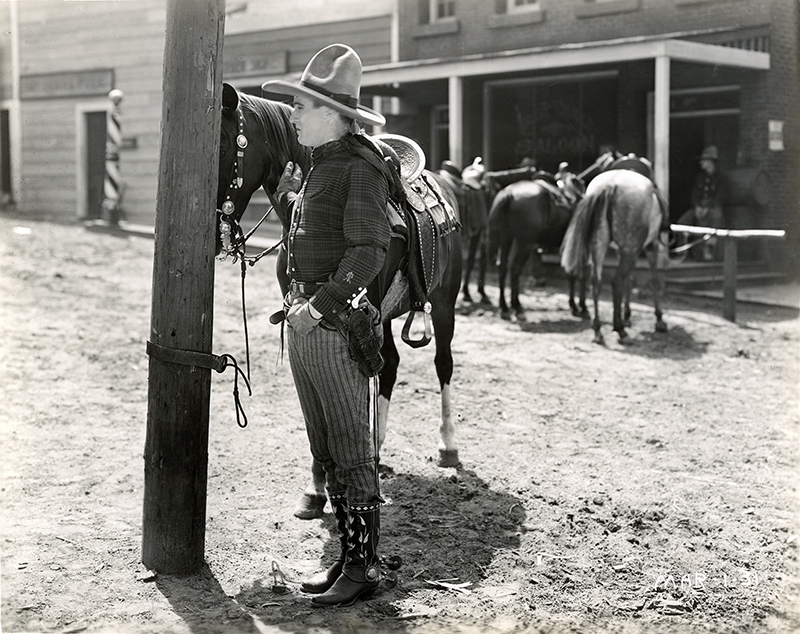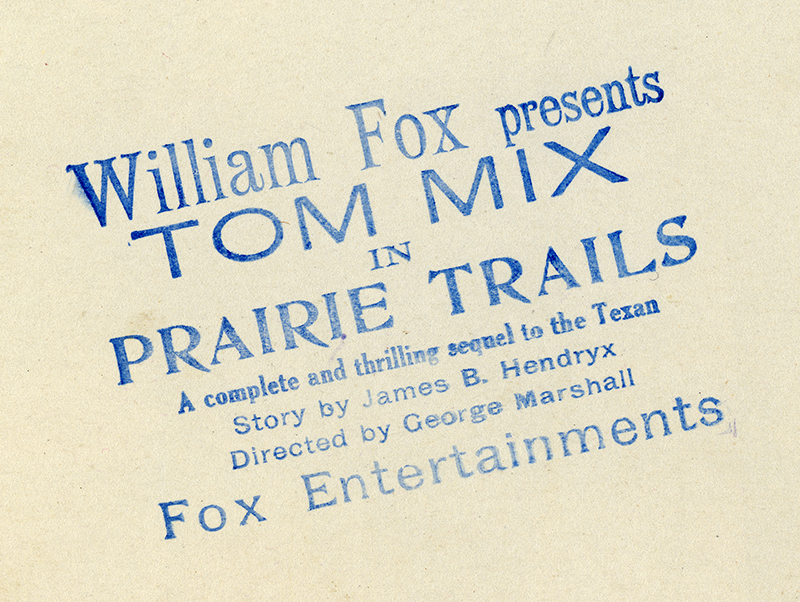"Prairie Trails"
Starring Tom Mix

Click image to enlarge
| Download archival scan
Tom Mix stares down a telephone pole that doubles as a hitching post for Tony, his "Wonder Horse," in "Prairie Trails," a comedic sequel to the more serious "The Texan." Both were written by James B. Hendryx and released back-to-back at the end of 1920. Mix biographer Bob Birchard (1993:161) attributes the different approaches (lesser or greater amounts of humor) to the difference in directors — Lynn F. Reynolds for "The Texan," George Marshall for "Prairie Trails" — although the scenario (screenplay) writers were different, too.
The "MAR" in the number at lower right in this 8x10 publicity photograph (MAR-1-13) probably stands for "Marshall." "Prairie Trails" was advertised as "a complete and thrilling sequel to the Texan." Studio press releases emphasized that you didn't need to see the last one to enjoy this one. We don't know where "Prairie Trials" was filmed. Mix used the Newhall area beginning in 1916, but by 1920 his home studio was the Fox lot in Edendale (Glendale). That said, he still did some occasional filming in Newhall. And other things. Earlier in 1920, he pleaded guilty in Judge John F. Powell's courtroom (which was in Powell's house on Railroad Avenue) to a charge of driving recklessly through the streets of Newhall. We know he was back in August 1921 when the film company burned down a house south of the town of Newhall for a scene in "Trailin'," starring Mix and Eva Novak. The picture for which he is best remembered locally, "3 Jumps Ahead," where he (supposedly) jumped over Beale's Cut south of Newhall, was made in 1923.
About Tom Mix. Born in Mix Run, Penn., on Jan. 6, 1880, Tom Mix appeared in more than 300 films (counting "shorts") from 1909 to 1935. He occasionally filmed in Newhall from 1916 to the mid-1920s and set up one of his early "Mixville" Western movie towns between Spruce Street (now called Main Street) and Newhall Avenue. A part-time Newhall resident during that period, Mix lived across the street (probably on Walnut Street) from the Thibaudeau home, which was located at the southwest corner of Market Street and Newhall Avenue. In a televised interview, lifelong Newhall resident Gladys Thibaudeau Laney (1910-2014) said she observed Tom buying his sidekick "wonder horse" Tony on her family's property when she was a young girl. The timing works; Tom reportedly purchased Tony for $600 in 1917 from Pat Chrisman (1882-1953), a horse trainer and actor friend who co-starred in a number of Mix films (Birchard 1993:118). In the late Teens, Mix established his most famous "Mixville" on Glendale Boulevard in the Silver Lake section of Los Angeles. Prior to his movie career, Mix appeared in a series of Wild West shows where he was noticed by pioneering film producer Col. William N. Selig, who hired him to handle horses. He worked with Selig, writing, directing and acting, until 1917, when he signed with Fox to star in moving pictures alongside Tony. Mix reached the height of his popularity during the 1920s, assuming the mantle of King of the Cowboys from William S. Hart, who retired from filming in 1925. But Mix did not adapt well to "talkies," and his career waned in the 1930s. His popularity remained intact, however, as he took his show on the road on the Western performance circuit. It was on the road that he would perish, when his 1937 Cord sent him to an untimely demise on Oct. 12, 1940, south of Florence, Ariz. Adding insult to injury and death, most of the 85 films he made with Fox were lost in a 1937 fire at the company's East Coast storage facility. But Mix was remembered fondly through his radio show and comic books, which outlived him by more than a decade.
LW3752: 9600 dpi jpeg from original photograph purchased 2020 by Leon Worden.
|

